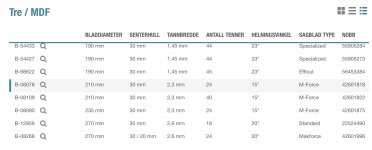I went on a quest lately looking for alternative blades for my TS75 and noticed a lot of concerns as it relates to using different blades with the same rail (splinter guard). Looking at blade kerf does not bring clarity here if you don't know the blade plate thickness and can't calculate the offset. The problem is - many manufacturers do not publish plate thickness, so unless you call them or take a plunge, buy a blade and measure it (as I did with Amana/AGE blades) there is no way to clear this confusion. So, here for everyone to use as a reference is my limited compilation of manufacturers and their part numbers with blade specifications. If you see some measurements missing, please feel free to post your own observations. Let's make this list as complete as possible together:
MODEL # TEETH GRIND KERF PLATE OFFSET APPLICATION
Festool
495378 16 ATB 2.6 mm 1.9 mm 0.35 mm Rip hard and soft woods
495379 18 ATB 2.6 mm 1.9 mm 0.35 mm Rip building panels, wood and soft plastics
495380 36 ATB 2.4 mm 1.9 mm 0.25 mm General purpose blade for wood and soft plastics; fine rip cut
495381 52 ATB 2.4 mm 1.9 mm 0.25 mm Fine for smooth cuts in veneered plywood, sheet goods, melamine, and hard and soft woods
495382 60 TCG 2.4 mm 1.9 mm 0.25 mm Solid Surface / Laminate
495383 72 TCG 2.4 mm 1.9 mm 0.25 mm Non-ferrous materials, especially aluminium; acrylics and hard plastics
495284 36 ATB 2.2 mm 1.9 mm 0.15 mm Steel
Amana/A.G.E.
MD210-160 16 ATB 2.6 mm 1.9 mm 0.35 mm Rip blade
MD210-182 18 ATB 2.6 mm 1.9 mm 0.35 mm Wood, building panels & soft plastics
MD210-360 36 ATB 2.4 mm 1.9 mm 0.25 mm General purpose
MD210-523 52 ATB 2.4 mm 1.9 mm 0.25 mm Fine crosscut in sheet goods, melamine
MD210-608 60 ATB 2.4 mm 1.9 mm 0.25 mm Solid surface and laminate
MD210-725 72 TCG 2.4 mm 1.9 mm 0.25 mm Aluminium and plastics
STL210-30 36 TCG 2.2 mm 1.9 mm 0.15 mm Alloy & Virgin Steel
Oshlun
SBFT-210036 36 ATB 2.4 mm 1.8 mm 0.3 mm Universal & General Purpose, Hardwood, Softwood, Soft Plastics
SBFT-210052 52 ATB 2.4 mm 1.8 mm 0.3 mm Fine Tooth & Crosscut, Hardwood, Softwood, Melamine
SBFT-210072A 72 TCG 2.4 mm 1.8 mm 0.3 mm Aluminum, brass, hard plastics
Tenryu
PSW-21018CBD3 18 ATB 2.3 mm 1.6 mm 0.35 mm Fast ripping on wood
PSW-21036CBD3 36 ATB 2.2 mm 1.6 mm 0.30 mm Combination (Ripping and cross cutting on wood)
PSW-21054AB3 54 ATAFR2.2 mm 1.6 mm 0.30 mm Fine cross cutting on wood
PSL-21052D3 52 TCG 2.3 mm 1.6 mm 0.35 mm Laminate, composite, or flooring materials cutting
PSA-21068D3 68 TCG 2.3 mm 1.6 mm 0.35 mm Aluminium cutting
CMT
290.210.24M 24 ATB 2.8 mm 1.8 mm 0.5 mm Rip hard and soft woods
291.210.36M 36 ATB 2.8 mm 1.8 mm 0.5 mm Rip and crosscuts on soft/hardwood and plywood
292.210.48M 48 ATB 2.8 mm 1.8 mm 0.5 mm For crosscuts on soft hard wood, wood-based panels, one-sided veneered, paper-based laminated
236.190.04M 4 Z4 Fiber cement boards: Eternit®, Swisspearl®, Fermacell®, Ivarplank®,
HardiePlank®, HardiePanel®, Corian®, Duroplast®, Formica®
Forrest
Ply Veneer 70 ATB 2.4 mm Cross cuts on all types of wood including birch plywood
MODEL # TEETH GRIND KERF PLATE OFFSET APPLICATION
Festool
495378 16 ATB 2.6 mm 1.9 mm 0.35 mm Rip hard and soft woods
495379 18 ATB 2.6 mm 1.9 mm 0.35 mm Rip building panels, wood and soft plastics
495380 36 ATB 2.4 mm 1.9 mm 0.25 mm General purpose blade for wood and soft plastics; fine rip cut
495381 52 ATB 2.4 mm 1.9 mm 0.25 mm Fine for smooth cuts in veneered plywood, sheet goods, melamine, and hard and soft woods
495382 60 TCG 2.4 mm 1.9 mm 0.25 mm Solid Surface / Laminate
495383 72 TCG 2.4 mm 1.9 mm 0.25 mm Non-ferrous materials, especially aluminium; acrylics and hard plastics
495284 36 ATB 2.2 mm 1.9 mm 0.15 mm Steel
Amana/A.G.E.
MD210-160 16 ATB 2.6 mm 1.9 mm 0.35 mm Rip blade
MD210-182 18 ATB 2.6 mm 1.9 mm 0.35 mm Wood, building panels & soft plastics
MD210-360 36 ATB 2.4 mm 1.9 mm 0.25 mm General purpose
MD210-523 52 ATB 2.4 mm 1.9 mm 0.25 mm Fine crosscut in sheet goods, melamine
MD210-608 60 ATB 2.4 mm 1.9 mm 0.25 mm Solid surface and laminate
MD210-725 72 TCG 2.4 mm 1.9 mm 0.25 mm Aluminium and plastics
STL210-30 36 TCG 2.2 mm 1.9 mm 0.15 mm Alloy & Virgin Steel
Oshlun
SBFT-210036 36 ATB 2.4 mm 1.8 mm 0.3 mm Universal & General Purpose, Hardwood, Softwood, Soft Plastics
SBFT-210052 52 ATB 2.4 mm 1.8 mm 0.3 mm Fine Tooth & Crosscut, Hardwood, Softwood, Melamine
SBFT-210072A 72 TCG 2.4 mm 1.8 mm 0.3 mm Aluminum, brass, hard plastics
Tenryu
PSW-21018CBD3 18 ATB 2.3 mm 1.6 mm 0.35 mm Fast ripping on wood
PSW-21036CBD3 36 ATB 2.2 mm 1.6 mm 0.30 mm Combination (Ripping and cross cutting on wood)
PSW-21054AB3 54 ATAFR2.2 mm 1.6 mm 0.30 mm Fine cross cutting on wood
PSL-21052D3 52 TCG 2.3 mm 1.6 mm 0.35 mm Laminate, composite, or flooring materials cutting
PSA-21068D3 68 TCG 2.3 mm 1.6 mm 0.35 mm Aluminium cutting
CMT
290.210.24M 24 ATB 2.8 mm 1.8 mm 0.5 mm Rip hard and soft woods
291.210.36M 36 ATB 2.8 mm 1.8 mm 0.5 mm Rip and crosscuts on soft/hardwood and plywood
292.210.48M 48 ATB 2.8 mm 1.8 mm 0.5 mm For crosscuts on soft hard wood, wood-based panels, one-sided veneered, paper-based laminated
236.190.04M 4 Z4 Fiber cement boards: Eternit®, Swisspearl®, Fermacell®, Ivarplank®,
HardiePlank®, HardiePanel®, Corian®, Duroplast®, Formica®
Forrest
Ply Veneer 70 ATB 2.4 mm Cross cuts on all types of wood including birch plywood

